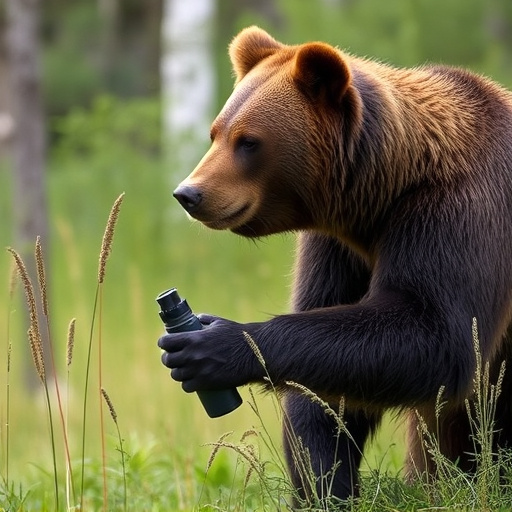Understanding bear behavior is key for safety in areas with bear populations. While regular pepper spray causes temporary distress, it's ineffective against bears due to their thick fur. Bear spray, designed specifically for bears, has higher capsaicin concentrations and can be sprayed from a greater distance, providing crucial seconds to escape. It's particularly effective against grizzlies and black bears, making it an indispensable tool for hikers and campers in bear country, emphasizing the significance of Bear Spray Vs Regular Pepper Spray.
In the vast wilderness, understanding bear behavior is paramount for survival. This article equips readers with essential knowledge on navigating potential bear attacks, focusing on effective protection methods. We explore ‘Bear Spray’ as a powerful defense mechanism, delving into its distinct properties compared to regular pepper spray. Additionally, we cover critical preparation tips and safety measures to enhance your chances of safe wilderness encounters. Stay informed, stay alive: master the art of self-defense against these majestic yet potent creatures.
- Understanding Bear Behavior and Attack Patterns
- Bear Spray: An Effective Defense Mechanism
- Regular Pepper Spray vs. Bear Spray: Key Differences
- Preparation and Safety Measures for Wilderness Encounters
Understanding Bear Behavior and Attack Patterns
Understanding bear behavior is crucial for anyone venturing into wilderness areas known for their bear populations. Unlike popular belief, bears typically avoid humans and only attack when they feel threatened or surprised. Black bears, common in many regions, tend to be more defensive than aggressive, often reacting to perceived threats by fleeing rather than attacking. However, grizzly bears, found mainly in North America, are more likely to stand their ground and fight back if they feel their cubs or food sources are threatened.
When considering protection from bear attacks, many turn to bear spray as a deterrent. Bear spray, designed specifically for use against bears, is more effective than regular pepper spray due to its longer range and higher concentration of capsaicin, the active ingredient that causes the burning sensation. It can provide a crucial few seconds to escape or deter an attack. However, it’s important to note that bear spray isn’t foolproof; proper knowledge of bear behavior, noise making, and avoiding surprising bears are still key components of safety in bear country.
Bear Spray: An Effective Defense Mechanism
Bear spray has emerged as a powerful defense mechanism in wilderness survival scenarios, offering a distinct advantage over regular pepper spray when facing bear encounters. While both types of spray aim to incapacitate through irritation, bear spray is specifically designed to deter aggressive bears, such as grizzly and black bears, which are known for their size and strength.
One key difference between bear spray and regular pepper spray lies in the concentration and composition of the irritants. Bear spray typically contains capsaicin, similar to regular pepper spray, but in much higher concentrations. This potency is crucial when facing larger bears, as it creates a more effective barrier, causing bears to retreat rather than continue an attack. Moreover, bear spray can be sprayed from a greater distance, providing a critical window of safety during unexpected encounters in remote areas.
Regular Pepper Spray vs. Bear Spray: Key Differences
When it comes to defending yourself against a bear attack, the choice between regular pepper spray and specialized bear spray is crucial. While both aim to incapacitate through irritation, they differ significantly in their effectiveness and range. Regular pepper spray, designed for human confrontations, uses capsaicin to cause temporary blindness, coughing, and difficulty breathing. However, it has limited effect on bears due to their thick fur and higher tolerance to capsaicin.
Bear spray, conversely, is specifically formulated to deter bears by targeting their eyes, nose, and mouth – areas less protected by fur. It contains a higher concentration of capsaicin and other ingredients that can be more effective against larger bears like grizzlies and black bears. Moreover, bear spray typically has a longer range, enabling users to create distance from the animal during a confrontation. This difference makes bear spray a vital tool for hikers, campers, and anyone venturing into bear country.
Preparation and Safety Measures for Wilderness Encounters
In preparing for a wilderness encounter, especially with potentially dangerous animals like bears, knowing your equipment and taking preventive measures are key. One crucial distinction to make is between bear spray and regular pepper spray. Bear spray, designed specifically for use against bears, typically contains capsaicin in higher concentrations than standard pepper spray, making it more effective at deterring aggressive encounters.
When venturing into bear country, always inform others of your itinerary, carry the appropriate bear spray, and make noise to signal your presence. Regular pepper spray can still be useful as a last resort, but for maximum protection against bears, the specialized bear spray is recommended due to its enhanced capsaicin levels and longer range, enabling a safer and more effective response during potentially life-threatening situations.
In the wild, understanding bear behavior and carrying the right protection are key to survival. Bear spray has emerged as a game-changer in personal defense, offering an effective solution against aggressive bears. When choosing between regular pepper spray and specialized bear spray, opt for the latter due to its increased concentration and specific design to deter larger, more powerful predators. Proper preparation and knowledge of safety measures can significantly enhance your chances during unexpected encounters in the wilderness. Always remember: understanding bear behavior and being equipped with the right tools are essential for navigating these encounters safely.
